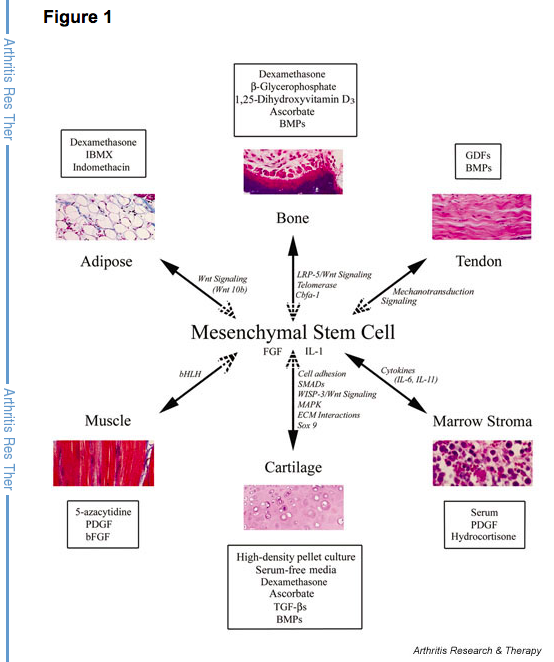I thought I could help out the regular and future readers (as well as myself) in understanding the possible ways the mesenchymal stem cells can differentiate into with a picture I found from a PubMed study. The study and article is entitled “Adult mesenchymal stem cells and cell-based tissue engineering.” (source link).
Note: For the complete article file in PDF form, click HERE.
Arthritis Res Ther. 2003;5(1):32-45. Epub 2002 Dec 11.
Adult mesenchymal stem cells and cell-based tissue engineering.
Source
National Institute of Arthritis, and Musculoskeletal and Skin Diseases, National Institutes of Health, Bethesda, Maryland, USA. Tuanr@mail.nih.gov
Abstract
The identification of multipotential mesenchymal stem cells (MSCs) derived from adult human tissues, including bone marrow stroma and a number of connective tissues, has provided exciting prospects for cell-based tissue engineering and regeneration. This review focuses on the biology of MSCs, including their differentiation potentials in vitro and in vivo, and the application of MSCs in tissue engineering. Our current understanding of MSCs lags behind that of other stem cell types, such as hematopoietic stem cells. Future research should aim to define the cellular and molecular fingerprints of MSCs and elucidate their endogenous role(s) in normal and abnormal tissue functions.
From the bottom of the source link page….
 Lineage potential of adult human MSCs. MSCs are characterized by their multilineage differentiation potentials, including bone, cartilage, adipose tissue, muscle, tendon, and stroma. This figure depicts some of the in vitro culture conditions (boxed) that promote the respective differentation process into a specific lineage. Signaling pathways and/or components or events shown to be involved in lineage-specific differentiation are in italics. See text for details.
Lineage potential of adult human MSCs. MSCs are characterized by their multilineage differentiation potentials, including bone, cartilage, adipose tissue, muscle, tendon, and stroma. This figure depicts some of the in vitro culture conditions (boxed) that promote the respective differentation process into a specific lineage. Signaling pathways and/or components or events shown to be involved in lineage-specific differentiation are in italics. See text for details.
Dotted arrowheads denote potential ‘reverse’ differentiation events. bFGF, basic fibroblast growth factor; bHLH, basic helix–loop–helix; BMP, bone morphogenetic protein; Cbfa1, core binding factor alpha 1; ECM, extracellular matrix; FGF, fibroblast growth factor; GDF, growth/differentiation factor; IBMX, 3-isobutyl-1-methylxanthine; LRP, low-density lipoprotein receptor-related peptide; MAPK, mitogen-activated protein kinase; PDGF, platelet-derived growth factor; SMAD, vertebrate homologue of DrosophilaMothers Against Decapentaplegic (MAD); TGF-β, transforming growth factor beta; WISP, Wnt-1-inducible protein.
Analysis:
We can see that the mesenchymal stem cells are a type of multi-potent progenitor stem cell which seems to be able to differentiate into many different types of cell types. In the article we learn that the mesenchymal stem cell is one of the main ideas people have for using the stem cells in tissue engineering.
If we focus just on the bones and cartilage, we can see that the picture is very clear in listing 1. the pathway, and 2. the types of growth factors or modulating factors which will help lead the mesenchymal stem cell to its desired outcome.
1. Bone
- Pathway and cause: LRP-5/Wnt Signaling, Telomerase & Cbfa-1
- Needed growth factors: Dexamethasone, BMPs, Ascorbate, Beta-Glycerophosphate, 1-25- DihydroVitamin D3,
2. Cartilage
- Pathway and cause: Cell Adhesion, SMADs, WISP-3/Wnt Signaling, MAPK, ECM Interactions, and Sox9
- Needed growth factors: High-density pellet culture, Serum-free media, Dexamethason, Ascorbate, TGF-Betas (1 & 2), BMPs
